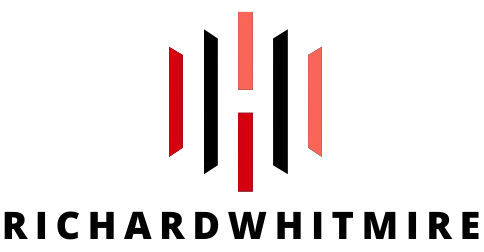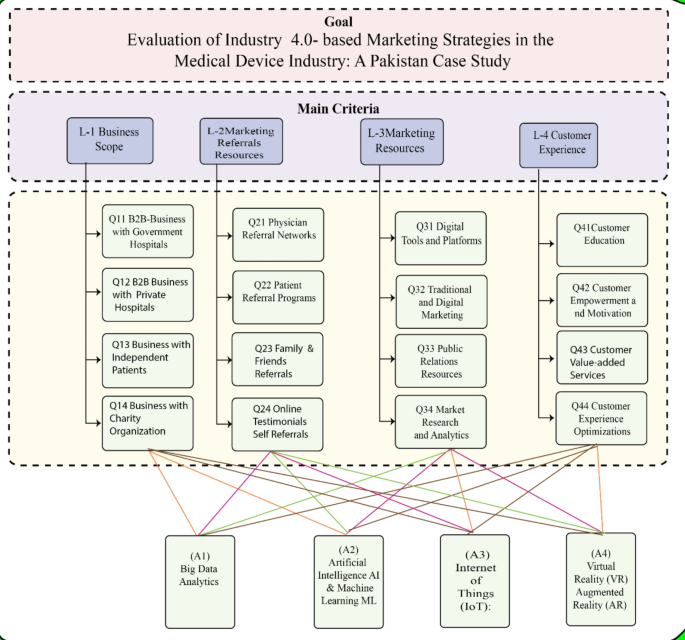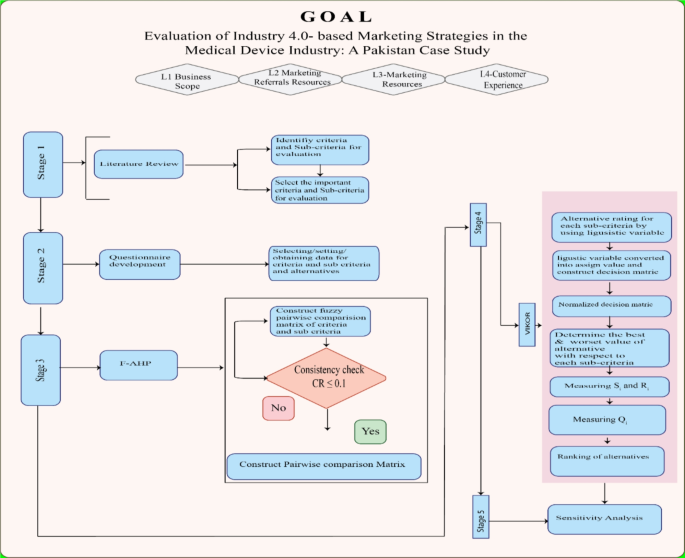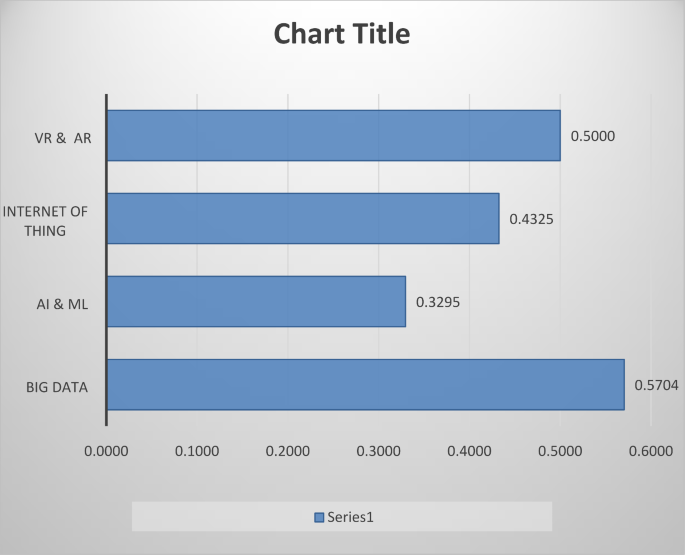The methodology presented explores uncharted territory in the P&O medical device industry and the design of related marketing strategies for business performance evaluation and improvement. Its focus is on prioritizing Industry 4.0 for multi-criteria decision-making (MCDM). It involves a combined F-AHP/ VIKOR model, and the procedure details have been reported previously39. Fuzzy sets and judgment matrices composed of triangular fuzzy numbers are utilized to determine ultimate weights, which are essential for our investigation40. The integration of these two methods is chosen as preferred research methodologies for their ability to incorporate fuzziness when determining weightage values for fuzzy criteria and sub-criteria, which has demonstrated effectiveness in hierarchical structure scenarios41 and its valuableness in ranking strategies, particularly when considering sub-criteria42. In practical application, the choices of each decision-maker are usually recorded and frequently combined, which is then presented for performance purposes. The matrix is an initial stage in prioritizing alternatives or identifying the best choice43.
This innovative study is a marketing approach to determine the highest priority of advanced technology within the industry 4.0 framework, specifically concerning P&O medical devices in emerging economies. It consists of obtaining data from survey responses from 16 subject experts with diverse backgrounds. The challenges encountered in this process include efficiently handling all data and criteria to understand performance while showcasing the significance of each criterion. This process is the chosen methodology and is a good choice as it is increasingly utilized across various fields, including information technology and medical diagnostics, to address real-life situations44. It is a valuable tool for establishing the basis for material selection, sorting, prioritization, and meaningful assessment45,46.
More specifically, analyzing the extrapolated data led to the creation of an integrated F-AHP/ VIKOR model for determining weightage values of the main criteria and sub-criteria. This combination serves as an effective MCDM technique validating its use in the context—the research process established objectives by gathering relevant criteria and evaluating the best Industry 4.0 technology alternatives. Cutting-edge Industry 4.0 technologies are applied and assessed according to impact on marketing performance and technological feasibility specific to P&O medical device perspectives. This is beneficial as it offers a systematic and evidence-driven approach for applying a linguistic scale. It provides solutions between criteria/sub-criteria to an alternative, enabling pairwise comparisons among suggested elements. This scale assessed the main criteria and sub-criteria, subjective attributes such as “very low,” “low,” “moderate,” “high,” and “very high” employed grade, assigning weights of 0.0, 0.25, 0.50, 0.75, and 1.00 correspondingly, thereby simplifying the optimal selection process within the framework.
MCDM proves particularly beneficial in addressing numerous intricate issues, particularly those centered on selecting the optimal solution. This solution selection involves considering various aspects of a problem; thus, many real-world scenarios require the involvement of multiple decision-makers47. The theoretical framework of MCDM is built upon the concept of employing positive and negative reference points, which function as benchmarks48. In practice, decisions from multiple decision-makers, usually presented in separate matrices, are merged to formulate a collective decision matrix. This is the first step in evaluating alternatives or finding the best-performing choice.
Proposed marketing approach
A proposed marketing approach is vital for positioning, ensuring relevance, and fostering communication with target audiences. It boosts revenue, expands market share, and supports sustainable growth49. Marketing facilitates adaptation to market changes, enhancing long-term sustainability. Through resource optimization and innovation, strategies maximize Return on Investment (ROI) and competitiveness50. This study offers unique insights into marketing performance for P&O medical devices. Advanced technologies like AI-driven customization necessitate clear communication of device benefits to P&O professionals and patients51. Tailored marketing efforts for personalized medical device solutions can enhance patient satisfaction52.
Research has highlighted next-generation marketing technologies from Industry 4.0 that are particularly relevant and transformative for the Prosthetics and Orthotics (P&O) medical device industry. These technologies were selected for their alignment with the objectives of optimizing business strategies, enhancing healthcare performance, and harmonizing marketing goals within the P&O sector. Moreover, they facilitate the use of advanced analytical tools, such as F-AHP and VIKOR models, reinforcing the study’s methodological framework.
The main and sub-criteria in the research paper were derived by conducting a Systematic Literature Review (SLR), beginning with the formulation of research questions centered on next-generation marketing expectations through the integration of Industry 4.0 technologies into the medical device industry to align marketing strategies with business performance. The search strategy was crafted using academic databases and keywords related to Industry 4.0, medical device marketing, and decision-making models such as F-AHP and VIKOR. Inclusion and exclusion criteria were applied to studies focusing on the intersection of these topics. After screening titles, abstracts, and full texts, key data was extracted and categorized based on Industry 4.0 tools, marketing strategies, and business growth as study objectives. The findings were synthesized to identify the main and sub-criteria used in the study. These criteria were incorporated into the research model, supported by evidence from the literature, ensuring the model’s effectiveness in optimizing marketing strategies and enhancing next business efficiency in the P&O sector. Furthermore, showcasing commitment to research and development through marketing builds stakeholder trust53.
Identified in this research study has the following main criteria related to P&O medical devices:
Business Scope (A1)54,55 Marketing Referrals Resources (A2)56, Marketing Resources (A3)57, and Customer Experience (A4)58,59,60 in business marketing strategy making it multi-dimensional. These will be explored in greater length and detail later in our “Results and discussion” section as they pertain to our P&O medical device industry findings.
Industry 4.0 technologies
While Industry 3.0 may lack the capabilities required for modern business marketing performance, such as data-driven insights, personalized experiences, agility, and integration across the entire value chain, Industry 4.0 offers a transformative marketing approach, enabling businesses to thrive in today’s digital landscape. Selective technologies related to Industry 4.0 are discussed as;
Big Data is essential for marketing performance as it offers real-time insights into consumer behavior, preferences, and trends. Marketers use it to personalize campaigns, optimize pricing, and measure success accurately. In prosthetics and orthotics, big data customizes devices, predicts maintenance needs, supports clinical decisions, and optimizes supply chains. By leveraging big data, businesses can enhance customer satisfaction, drive growth, and achieve marketing performance goals effectively. Marketers use big data to make data-driven decisions, personalize campaigns, target specific segments, and optimize ROI. In prosthetics and orthotics, big data improves patient outcomes, streamlines manufacturing, and enhances efficiency throughout the supply chain.
Integrating AI and ML into marketing performance enables more intelligent decision-making, enhanced personalization, and improved efficiency, driving growth and competitive advantage. AI offers advanced analytics, predictive insights, automation, and campaign optimization. In P&O, significant data customization, quality control, clinical support, and R&D advancements are facilitated. Big data analytics collect patient data for personalized devices, ensure manufacturing quality, inform clinical decisions, and drive innovation. Ultimately, big data enhances patient outcomes, operational efficiency, and innovation in prosthetics and orthotics, aligning with broader marketing strategies leveraging AI and ML for growth and customer satisfaction.
Incorporating IoT technology into marketing strategies to collect real-time data offers enhanced customer insights, contextual marketing, and seamless Omni-channel experiences. IoT data enables real-time insights, granular data analysis, and predictive analytics for better decision-making. It enhances customer experience, drives product innovation, and ensures competitive advantage. In P&O, considerable data customization, quality control, clinical support, and R&D advancements are facilitated. Big data accelerates innovation, improves patient outcomes, and enhances operational efficiency in the field. Leveraging IoT data in marketing strategies aligns with broader business goals, driving growth, customer satisfaction, and innovation in today’s digital landscape.
Incorporating VR and AR into marketing strategies offers immersive experiences, product visualization, and interactive engagement. These technologies differentiate brands, foster loyalty, and provide valuable data insights. Extensive data customization, quality control, clinical support, and R&D advancements are facilitated in prosthetics and orthotics. Big data drives innovation, improves patient outcomes, and enhances operational efficiency in the field. Leveraging VR and AR technologies aligns with broader marketing performance goals, creating memorable experiences, driving engagement, and effectively achieving marketing objectives.
It is essential for each country, based on a healthcare system as a business or social service, to conduct research that presents individual factor ranking based on importance within the industry. At the same time, it looks ahead to the future as either a government organization or a privately run business.
The research methodology commenced with identifying subject matter experts, as shown in Fig. 1, followed by developing a survey questionnaire. The aim of opinion sourcing involved soliciting perspectives from the host country’s technology professionals, healthcare departments, and clinicians to ensure a comprehensive breadth and variability of subjects aligned with the research objective, aiming to achieve robust outcomes while mitigating bias. The study’s reliability depends on the precision of multiple determining factors, alongside research for evaluation that stays aligned with the continuously evolving technological landscape. Figure 2 presents the model and stages for the proposed research.
Proposed model
The research study translated the criteria and sub-criteria into F-AHP and VIKOR modelling questionnaires. A fuzzy matrix for criteria was employed in F-AHP to test the framework, where various criteria factors were assigned designated numerical positions, each linked to a priority vector and indicating its relative importance within the parent-level framework component. This approach facilitated the main criteria normalization of values using the matrix’s eigenvector, ensuring consistency in scores across the comparison matrix, as demonstrated in Tables 2 and 3 for the main criteria. Furthermore, a weighting model was proposed to convert the results into ultimate weights, quantifying subjective variables.
In the FAHP model, subject experts evaluated initial comparison matrices of criteria, showcasing the pairwise comparison matrix results for the main criteria. Subsequently, fuzzy survey findings were utilized to weigh the main criteria in the FAHP model, delineating alternative Industry 4.0 technology sources for healthcare marketing. Experts outlined criteria for components of F-AHP, establishing relative to alternative components.
The subsequent step involved calculating a normalized principal eigenvector as a priority vector. This vector was employed to determine the significance of each component at its parent level, ensuring consistency of results over time.
Moreover, fuzzy logic was employed to compute the AHP pairwise comparison matrix and sub-criteria outcomes. This was done to obtain weightage values for sub-criteria to criteria, e.g. Business Scope (A1), Marketing Referrals Resources (A2), Marketing Resources (A3), and Customer Experience (A4). as presented in Tables 4, 5, 6 and 7.
Subsequently, the overall global weightage is discussed, and then Criteria and sub-criteria with assigned weightage values cover all proposed factors as outlined in Table 8.
The results of the comparison matrix indicate a substantial relationship by value among sub-criteria, emphasizing the significance of selective sub-criteria such as Business with private hospitals (0.0451), Patient referrals (0.0394), Public relationship (0.0542), and Customer empowerment (0.0498).
The Sensitivity Assessment evaluates how parameter values affect the outcomes. It investigates significant findings concerning variations in values ranging and emerging as optimal choices. However, as the ‘ν’ value increases from 0.5 to 0.8, A2 yield identical results as the best alternatives. Decision-makers strive to choose the most appropriate option from the available choices for marketing performance while minimizing value biases. Table 9 displays all four options for consideration.
This presents a higher-ranking value when it exhibits the smallest value among the proposed alternative Industry 4.0 technological tools. In the results of the marketing study, Fig. 3, the ranking of healthcare technology is determined based on the minimum value of “Artificial Intelligence & Machine Learning,” having the lowest index value (Qi) of 0.3295, thus making it the top choice. Subsequently, (A3-0.4325), representing the “Internet of Things,” is ranked second choice. “Virtual Reality & Augmented Reality” (A4-0.5000) occupies the third position, while “Big Data” (A1-0.5704) is considered the least favored choice.
The VIKOR model currently requires examining expert-selected data to determine the optimal source of tools among alternatives, followed by calculation. The pairwise comparison matrix presents the main criteria alternative in Table 10.
Normalizing the decision matrix determines the ideal A (positive) or A* (harmful) solutions to ensure a bias-free selection of technology as alternative ranking options, considering both unity and regret measures to acknowledge performance direction. The procedure is iterated for all attributes concerning all alternatives, with the results computed, and Table 11 presents the “Sij” utility matrix. It presents unity and regret measures for all four options, which are used to priorities the rank of technologies. The index value Qi for these alternatives is subsequently examined to validate the findings. This index value indicates the optimal solution and highest rank, which is signified by having the smallest value among the proposed alternatives.






